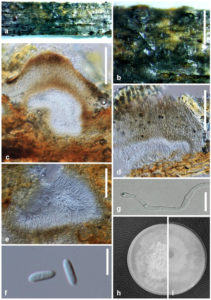Diaporthe dorycnii Dissanayake, Camporesi & K.D. Hyde, sp. nov., Index fungorum number: IF553188
Etymology: The specific epithet dorycnii is based on the host genus (Dorycnium).
Saprobic on dead aerial stem of Dorycnium hirsutum L. Sexual morph: Not observed. Asexual morph: Conidiomata up to 420 μm in diameter, 380 μm high, superficial or immersed, solitary or gregarious, scattered on host surface, globose, dark brown to black, clustered in groups of 2-5 conidiomata. Peridium 35–50 μm thick, inner layer composed of light brown textura angularis, outer layer composed of dark brown textura angularis. Conidiophores 21–35 × 1.5–2.5 μm (x̅ = 27 × 2 μm), cylindrical, aseptate, densely aggregated, straight or sinuous, terminal, slightly tapered towards the apex. Conidiogenous cells 13–19 × 2–3 μm hyaline, subcylindrical and filiform, straight, tapering towards the apex. Alpha conidia 9–13.5 × 3–4 μm (x̅ = 11 × 4 μm) hyaline, biguttulate, fusiform or oval, both ends obtuse. Beta conidia not observed.
Culture characteristics: Colonies on PDA covering entire Petri dishes after 10 days, flat, with an entire edge, aerial mycelium forming concentric rings with cottony texture, white, olivaceous on surface.
Material examined: ITALY, Forlì-Cesena Province, Fiumicello di Premilcuore, on dead aerial stem of Dorycnium hirsutum (Fabaceae), 2 May 2016, Erio Camporesi; (MFLU 16-1322, holotype); ex-type living culture MFLUCC 17-1015.
Notes: Diaporthe dorycnii occurs in a clade separate from D. diospyricola, D. chamaeropsis and D. cytosporella with high bootstrap support. Diaporthe diospyricola differs from D. dorycnii, in the presence of beta conidia. Phylogenetically, D. diospyricola is the closest species to D. dorycnii, differing by 24 nucleotides in the ITS region. Though the sequences of EF region, BT region and CAL region are available for D. dorycnii, the sequences of those regions are unavailable for D. diospyricola and thus the nucleotide comparison is incomplete.
Fig. Diaporthe dorycnii (MFLU 16-1322, holotype). a, b Conidiomata on host surface. c Cross section of conidioma. d Peridium. e, Conidia attached to conidiogenous cells. f Alpha conidia. g Germinating conidium. h, i Culture on PDA after one week. Scale bars: b = 1 mm, c–e = 100 μm, f = 10 μm, g = 20 μm.

